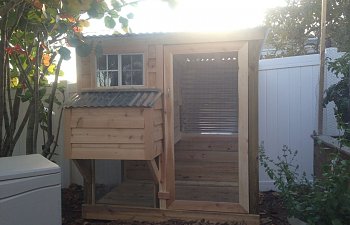Brock and I built our small backyard coop in April 2014 for our four RIRs. We explored options for prefab coops but decided that building one that was custom fit to our environment would be more cost efficient down the road. We live in a beachside community in Florida, so we have heat, extreme humidity and lots of salty air to factor into our design.

We began with a 4' x 6' x 6' run design.

And added a 4' x 3' x 4' roost box above the run.

We built the nest box off the front of the roost box, which is approximately 1' x 2' x 1' with two 12" x 12" nest boxes. There is lidded access to the nest box with a latch to keep out unwanted guests.

A shed window was installed so that the window can be opened horizontally to allow for extra ventilation in the roost box if needed. It also gives the chickens something to look out while they are sitting on the roost poles.

Inside the coop, there are two access doors on the roost box. The smaller one at the bottom is for the chickens and the larger one is for the humans to access the roost box for cleaning, etc. There is also a hinged opening on the bottom of the roost box which allows access to remove the trays in the bottom of the roost box for cleaning. The trays are actually one large plastic tray that you would use in the bottom of a dog kennel that we cut it in half to make removing and replacing easier.

Inside the roost box, there are three roost poles - two were made from branches from the sea grapes in our backyard and the other pole is actually a support beam on which my husband rounded the edges so the chicken could roost on it without damaging their feet.


We decided to completely enclose the back wall of the coop. The location next to our fence caused rain water to run off the roof of the coop and splash against the fence and into the run. It also created a more aesthetically pleasing appearance.

Here is the "completed" construction (The watering system had not been installed when this photo was taken).

We added a slide lock just below the handle as well the block lock to the bottom to help keep unwanted guests from being able to pry open the door.

The watering system (not pictured) is located in this area, with three watering stations. There are two additional watering stations in the roost box. We wanted to be sure that the chickens had access to water at all times especially since we live in an area with warmer temperatures.

Here is a walk-through video of the coop with the food and watering systems in place.
We began with a 4' x 6' x 6' run design.
And added a 4' x 3' x 4' roost box above the run.
We built the nest box off the front of the roost box, which is approximately 1' x 2' x 1' with two 12" x 12" nest boxes. There is lidded access to the nest box with a latch to keep out unwanted guests.
A shed window was installed so that the window can be opened horizontally to allow for extra ventilation in the roost box if needed. It also gives the chickens something to look out while they are sitting on the roost poles.
Inside the coop, there are two access doors on the roost box. The smaller one at the bottom is for the chickens and the larger one is for the humans to access the roost box for cleaning, etc. There is also a hinged opening on the bottom of the roost box which allows access to remove the trays in the bottom of the roost box for cleaning. The trays are actually one large plastic tray that you would use in the bottom of a dog kennel that we cut it in half to make removing and replacing easier.
Inside the roost box, there are three roost poles - two were made from branches from the sea grapes in our backyard and the other pole is actually a support beam on which my husband rounded the edges so the chicken could roost on it without damaging their feet.
We decided to completely enclose the back wall of the coop. The location next to our fence caused rain water to run off the roof of the coop and splash against the fence and into the run. It also created a more aesthetically pleasing appearance.
Here is the "completed" construction (The watering system had not been installed when this photo was taken).
We added a slide lock just below the handle as well the block lock to the bottom to help keep unwanted guests from being able to pry open the door.
The watering system (not pictured) is located in this area, with three watering stations. There are two additional watering stations in the roost box. We wanted to be sure that the chickens had access to water at all times especially since we live in an area with warmer temperatures.
Here is a walk-through video of the coop with the food and watering systems in place.

